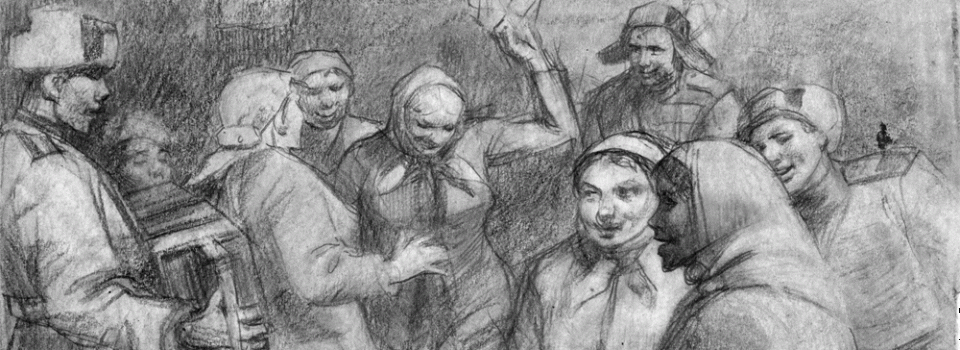The years of 1939-1945 became the most tragic in the history of mankind. The Second World War took the lives of over 60 million people and broke the hearts of even more families and friends around the globe. Every day takes us further away from those times and there are fewer surviving participants and witnesses left among us. This makes war-time records increasingly precious for us and especially younger generations. Works of art created during the years of the Second World War are of special historical and artistic value.
Thousands of posters, drawings, paintings and sculptures were produced in Great Britain and the Soviet Union during the period of 1939-1945. Some of them were born under the patronage of their respective government schemes, others by the initiatives of the artists themselves. Official artists, who recorded the war, are often predominantly known in their home countries. Many of their works constitute an important part of both state and private collections and are being exhibited nationally.
There are also artists, whose works were not commissioned and are rarely displayed to a wider public, both at home and abroad. Their life drawings, watercolours and sketches made as active soldiers at the front, during rare moments of calm between the battles and in the besieged Leningrad represent unique personal encounters of people, places and happenings experienced by the artists on their wartime journeys. Some of these visual records were created spontaneously and at immense speed, which radiate the extraordinary sincerity and emotional intensity of the moment. Others were conceived from reflections on personal and often traumatic experiences.
Unfortunately, there have been only a few accounts of Soviet visual art of the Second World War being exhibited in the United Kingdom and vice versa. This area can be identified as a noticeable gap in the understanding of art and history of the period as well as cross-cultural studies of the two countries. 2020 marks the 75th anniversary of the end of the world’s most tragic military conflict. This time can be seen as an appropriate occasion to shine more light onto that interesting era via the medium of art – in memory of all those who fought against fascism across the borders; for better understanding of each other, our shared past and future.
This website provides insight into the personal histories and memories and presents selected artworks created by Russian veterans of the Second World War. This is the start of a virtual museum of unofficial wartime art and memories of those who took part in the Second World War. Please contact us if you have any information you would like to share about your families and friends, who might have recorded their memories at war. You are also welcome to write to us with any ideas and suggestions about further developing this project. info@wartimeart.com
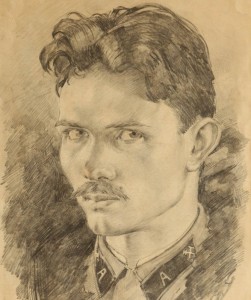 Pavel Afonin, Self-Portrait, 1942 |
Pavel Ivanovich Afonin (1920-2011)An honoured architect of the Russian Federation, Professor of Architecture and an artist. Pavel joined the front after finishing the third year of studies at the Moscow Architectural Institute at the age of 21 as a sapper and went through to the end of the war, storming Berlin in May 1945. Pavel was awarded four orders and eighteen medals for his service and the courage he demonstrated in some of the most decisive battles, including the liberation of Leningrad, Warsaw and Tallinn. He created over 200 sketches and drawings during the years of war. Most of them are portraits of his brothers-in-arms. After the war he graduated from the Moscow Architectural Institute, worked on the reconstruction of Kalinigrad and after moving to Leningrad, dedicated the rest of his life to teaching architecture and painting.
|
Sergey Fedorovich Babkov (1920-1993)An acclaimed Russian artist, member of the War Artists Studio named after M.B.Grekov. He fought in the artillery in the years 1942-1945 and took part in the legendary battles of Kursk and Berlin. Sergey finished the war with the title of Senior Lieutenant and received three orders and several medals. He created a series of unique sketches and watercolours of his war-time impressions. After the war he graduated from the Leningrad Academy of Arts and joined the War Artists Studio in Leningrad. War memories never set him free. Sergey and Pavel became acquainted after the war and continued painting together for many years. They helped to build a special archive of personal records of war, which are of unique historical and artistic value for generations to come. The material is sourced from family archives of the surviving relatives of the artists in the USA, Russia and the UK. |
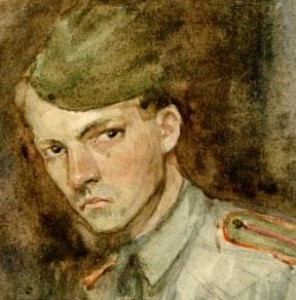 Sergey Babkov, Self-portrait 1943 |
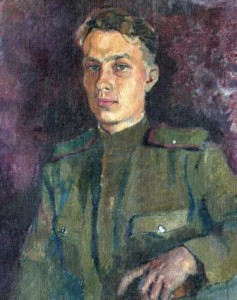 Atanov, self-portrait, 1941 |
Atanov Vladimir Sergeevich (1919-2011)An honoured architect of the Russian Federation, Professor of Painting and acclaimed master of watercolour painting. He joined the front in 1941 and went through the war leading the mortar company, taking part in the battles of Leningrad, on the Mannerheim Line, in Vyborg and Kurlandia. For participation in fighting V.S.Atanov was awarded two orders, including the Order of the Red Star (1943) and ten medals. Vladimir carried a set of watercolours with him through the years of war, making sketches between the fighting. Unfortunately, only a few of them survived. Vladimir and Pavel got to know each other during the entry exams at the Moscow Architectural Institute, then volunteered to go to the front, but fought in different troops. They went through the war and met three times at the front. They claimed that art helped them to stay alive. They completed their studies following the end of the war and maintained their friendship until the last days of their life. We are grateful to Vladimir’s daughter Natalia for sharing information from her family archives. |
Elena Oskarovna Marttila (b. 1923)An accomplished graphic artist and member of the Saint Petersburg Union of Artists. She had just finished the Art School of the All Russian Academy of Arts when war broke out in Russia. She lived through the hardest winter of 1941–2 in the besieged Leningrad, working as a nurse and helping to evacuate children, and continued drawing. After the war Elena graduated from the Leningrad Art School where she continued to teach for many years. She also worked as a theatre artist and created stage designs for over 50 theatrical performances. Elena created a collection of engravings on cardboard and lithographs based on sketches she made during the war. She confesses that wartime memories had the strongest impact on her life and art. |
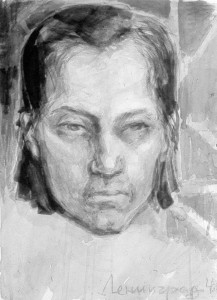 Elena Marttila. Self-portrait.1942 |
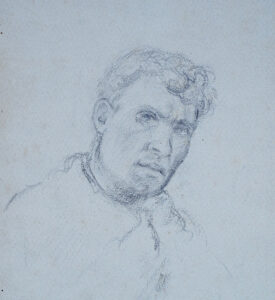 G.Malysh.Self-portrait.1937 |
Gavriil Kondratyevich Malysh (1907-1998)A distinguished watercolour artist. He graduated from the Odessa Art Institute before relocating to Leningrad where he worked as a lead artist at the State Leningrad Museum of Agricultural Reconstruction at the start of the war. Gavriil stayed and worked in the besieged Leningrad during the years of war, creating agitation and propaganda posters and wallpapers. At the same time, he continued exploring watercolour and created a series of “unofficial” landscape paintings of Leningrad and reconstructed memories of the sights of his beloved Ukraine. |
